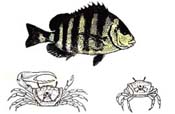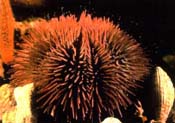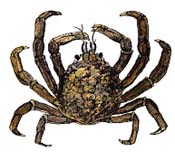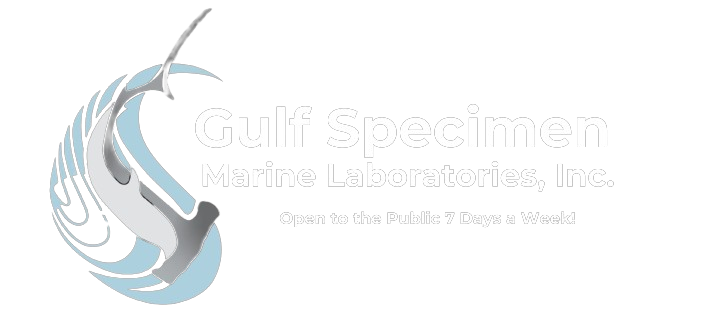 |
Sea Whip – Leptogorgia virgulata A soft coral that grows on rocks and shells from the intertidal zone to 200 feet, in a multitude of colors. The coloring is derived from a colorless organic molecule that becomes colored when bound into the calcium matrix. Class: Anthozoa; sub-class: Octocorallia |
 |
Serpent Star – Ophioderma brevispinum When darkness falls, these small bodied, long armed sea stars slip out from beneath the rocks or sea weed and propel themselves forward, twisting and writhing like small octopuses. A piece of fish dropped in the aquarium sends them into a feeding frenzy, as they wrap themselves around the food, engulfing it until its devoured. Class: Stelleroidea; sub-class: Ophiuroidea |
 |
Sheepshead – Archosargus probatocephalus A handsome black and white striped fish, common around wharf pilings and oyster bars. They have powerful jaws used to demolish shellfish and barnacles. Fishermen catch them using fiddler crabs as bait. Family: Sparidae/Porgies |
 |
Short Spined Sea Urchin – Lytechinus variegatus Bristling with spines, it uses tiny teeth in its Aristotle's Lantern to graze on algae growing on turtle grass. Often it covers its body with shells and debris to protect it from ultraviolet light. Class: Echinoidea |
 |
Spider Crab – Libinia emarginata and Libinia dubia One of the most abundant crabs in North Florida especially during the winter, they feed on carrion and sea anemones. They are a pest to blue and stone crab fishermen because they enter their traps and steal their bait. Highly sensitive to salinity changes, they flee fresh water. Some tear sponges and hydroids apart and stick it on their backs as a decorating camouflage. Dwarf Spider crab, Libinia dubia, often decorates itself with hydroids, sponges and encrusting sea squirts to hide from predators. Subphylum: Crustacea; Infraorder: Brachyura |
| « Previous | Next » | |
